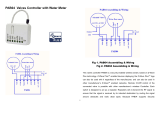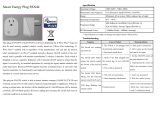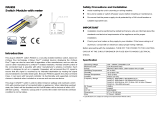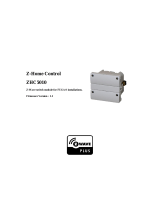
www.zyxel.com
www.zyxel.com
User’s Guide
Z-Wave Series
SHD1110/1111/2110/3110
Copyright © 2011
ZyXEL Communications Corporation
Edition 1, 7/2011


About This User's Guide
Z-Wave Series Programming Guide
3
About This User's Guide
Intended Audience
This manual is intended for people who want to configure the Z-Wave Series products.
Related Documentation
•Quick Start Guide
The Quick Start Guide is designed to help you get up and running right away. It contains
information on making your hardware connections.
•ZyXEL Web Site
Please refer to www.zyxel.com
for additional support documentation and product certifications.
Document Conventions
Warnings and Notes
These are how warnings and notes are shown in this guide.
Warnings tell you about things that could harm you or your device.
Note: Notes tell you other important information (for example, other things you may
need to configure or helpful tips) or recommendations.
Syntax Conventions
• The Z-Wave Series may be referred to as the “Z-Wave Series”, the “ZyXEL device”, or the
“device” in this guide.
• Product labels, screen names, field labels and field choices are all in bold font.
• A key stroke is denoted by square brackets and uppercase text, for example, [ENTER] means the
“enter” or “return” key on your keyboard.
• “Enter” means for you to type one or more characters and then press the [ENTER] key. “Select”
or “choose” means for you to use one of the predefined choices.
• Units of measurement may denote the “metric” value or the “scientific” value. For example, “k”
for kilo may denote “1000” or “1024”, “M” for mega may denote “1000000” or “1048576” and so
on.
• “e.g.,” is a shorthand for “for instance”, and “i.e.,” means “that is” or “in other words”.

Safety Warnings
Z-Wave Series Programming Guide
4
Safety Warnings
• Do not dispose of electrical appliances as unsorted municipal waste, use separate collection facilities.
• Contact your local government for information regarding the collection systems available.
• If electrical appliances are disposed of in landfills or dumps, hazardous substances can leak into the
groundwater and get into the food chain, damaging your health and well-being.
• When replacing old appliances with new once, the retailer is legally obligated to take back your old appliance
for disposal at least for free of charge.
Your product is marked with this symbol, which is known as the WEEE mark. WEEE stands for Waste
Electronics and Electrical Equipment. It means that used electrical and electronic products should not be
mixed with general waste. Used electrical and electronic equipment should be treated separately.

Table of Contents
Z-Wave Series Programming Guide
5
Table of Contents
About This User's Guide..........................................................................................................3
Document Conventions ...........................................................................................................3
Safety Warnings........................................................................................................................4
Table of Contents .....................................................................................................................5
Chapter 1
The Z-Wave Series....................................................................................................................7
1.1 Overview ................................................................................................................................7
Chapter 2
SHD1110 Programming............................................................................................................8
2.1 Z-Wave Groups (Association Command Class Version 2) .....................................................8
2.1.1 Grouping 1 ....................................................................................................................8
2.1.2 Grouping 2 ....................................................................................................................9
2.1.3 Z-Wave’s Configuration ..............................................................................................10
2.1.4 Auto Report ................................................................................................................11
2.1.5 Wakeup Configuration ................................................................................................12
2.1.6 Command Classes .....................................................................................................12
Chapter 3
SHD1111 Programming ..........................................................................................................13
3.1 Z-Wave Group (Association Command Class Version 2) ....................................................13
3.1.1 Tamper Event Report (Alarm Report) .........................................................................13
3.1.2 Control other Z-Wave Devices ....................................................................................13
3.1.3 Z-Wave’s Configuration ..............................................................................................13
3.2 Advanced Programming .......................................................................................................14
3.2.1 Battery Check Command ...........................................................................................14
3.2.2 Wakeup Command Class ...........................................................................................14
3.2.3 Command Classes .....................................................................................................15
Chapter 4
SHD2110/3110 Programming .................................................................................................16
4.1 Basic Command Class / Binary Switch Command Class ....................................................16
4.1.1 BASIC_GET / BINARY_SWITCH_GET ......................................................................16
4.1.2 BASIC_SET / SWITCH_BINARY_SET ......................................................................16
4.2 Z-Wave Groups (Association Command Class Version 2) ...................................................17
4.2.1 Grouping 1 ..................................................................................................................17

Table of Contents
Z-Wave Series Programming Guide
6
4.2.2 Grouping 2 ..................................................................................................................18
4.2.3 Z-Wave’s Configuration ..............................................................................................18
4.2.4 Meter Command Class ...............................................................................................19
4.2.5 Command Classes .....................................................................................................20
Appendix A Legal Information................................................................................................21

Z-Wave Series Programming Guide 7
CHAPTER 1
The Z-Wave Series
1.1 Overview
This User’s Guide provides programming methods for the Z-Wave Controller which controls each Z-
Wave Series device and unifies them into a Z-Wave network to control your home electronics. See
the figure below for the sample scenario of a Z-Wave network.
For instructions on hardware and basic setup of each individual Z-Wave device, see the respective
Quick Start Guides.

Z-Wave Series Programming Guide 8
CHAPTER 2
SHD1110 Programming
2.1 Z-Wave Groups (Association Command Class Version 2)
On the Z-Wave Controller, you can set the SHD1110 to send reports of itself (including power,
temperature, humidity, and battery status) to associated nodes of Grouping 1 or control
associated Z-Wave devices of Grouping 2. Grouping 1 supports one node and Grouping 2 supports
up to three nodes.
2.1.1 Grouping 1
Grouping 1 includes the following commands: POWER_APPLIED, SENSOR_MULTILEVEL
_REPORT, ALARM_REPORT and BATTERY_REPORT_COMMAND.
2.1.1.1 POWER_APPLIED command
When power is applied to the SHD1110, the ALARM_REPORT command will be sent to Grouping 1
to inform that the SHD1110 is powered up.
2.1.1.2 MULTILEVEL_SENSOR_REPORT
The SHD1110 automatically sends out SENSOR_MULTILEVEL_REPORT, containing its current
temperature and humidity, to Grouping 1. Refer to the Z-Wave’s Configuration section on page 10
for settings of auto report configuration.
Humidity
The following parameters are used in this example:
Sensor Value 1 = 0x23
Humidity Value = Sensor Value = 35 (%)
ALARM_REPORT Command
[Command Class Alarm, Alarm Type = 0x02, Alarm Level = 0x01]
SENSOR_MULTILEVEL_REPORT
[Command Class Sensor Multilevel, Sensor Multilevel Report, Sensor Type = 0 x
05 (Relative Humidity), Precision+Scale+Size = 0 x 01, Sensor Value 1 = 20-
90%]

Chapter 2 SHD1110 Programming
Z-Wave Series Programming Guide
9
Temperature (Celsius)
The following parameters are used in this example:
Sensor Value 1 = 0x01
Sensor Value 2 = 0x31
Temperature (C)= (Sensor Value 1*256 + Sensor Value 2)/10 = (1*256+49)/10 = 30.5 (C)
Temperature (Fahrenheit)
2.1.1.3 Low Battery Report
When the battery level of the SHD1110 drops to a low level, the icon will appear on the
SHD1110’s LCD and the detector will emit ALARM_REPORT command to Grouping 1.
The Z-Wave Controller may enquire the battery status of the SHD1110 by sending BATTERY_ GET.
Once the SHD1110 receives the command, it will return BATTERY_REPORT command to the
controller.
If the message shows "Battery Level = 255 (0xFF)", it implies that the SHD1110 is at low battery
status. Please replace the batteries as soon as possible, otherwise the SHD1110 will shut down.
Note: The SHD1110 will send out a low battery command as long as there is a device
associated into Grouping 1 of the SHD1110, even if the RF function is set to disable.
2.1.2 Grouping 2
Grouping 2 includes the BASIC_SET commands.
SENSOR_MULTILEVEL_REPORT
[Command Class Sensor Multilevel, Sensor Multilevel Report, Sensor Type = 0 x
01 (Air Temperature), Precision+Scale+Size = 0 x 22, Sensor Value 1 = (High
Byte of Temperature Value), Sensor Value 2 = (Low Byte of Temperature Value)]
SENSOR_MULTILEVEL_REPORT
[Command Class Sensor Multilevel, Sensor Multilevel Report, Sensor Type = 0 x
01 (Air Temperature), Precision+Scale+Size = 0 x 2A, Sensor Value 1 = (High
Byte of Temperature Value), Sensor Value 2 = (Low Byte of Temperature Value)]
ALARM_REPORT Command
[Command Class Alarm, Alarm Type = 0x01, Alarm Level = 255(0xFF)]
BATTERY_REPORT
[Command Class Battery, Battery Report, Battery Level = 20%-100%]

Chapter 2 SHD1110 Programming
Z-Wave Series Programming Guide
10
When the SHD1110 is triggered, it will send out BASIC_SET_COMMAND to the nodes of Grouping
2.
Refer to the Z-Wave’s Configuration section to configuration parameter 1 for the setting of basic set
command.
2.1.3 Z-Wave’s Configuration
The table below lists the configuration parameters and the value range for users to set up the
SHD1110.
[Command Class Basic, Basic Set, Value = (255)0xFF]
send trigger-ON command
[Command Class Basic, Basic Set, Value = 0(0x00)]
send trigger-OFF command
Table 1 Z-Wave Configuration Table
PARAMETER FUNCTION SIZE (BYTE) VALUE UNIT
FACTORY
DEFAULT
DESCRIPTION
1Basic Set
Level
10~99% of
Brightness
(Dimmer
Level)
99 / 99 Set basic set value to
be on (or Dim Level)
/off.
0: Disable
2Temperature
Trigger-ON
Value
1 -20~50
or
99
Degree 30 / 99 Set temp.trigger-ON
value to be _ degree.
99: Clear Temp.
trigger-ON value
3Temperature
Trigger-OFF
Value
1-20~50
or
99
Degree 20 / 99 Set temp.trigger-OFF
value to be _ degree.
99: Clear Temp.
trigger-OFF value
4Humidity
Trigger-ON
Value
1 20~90
or
99
% 50 / 99 Set humid. trigger-
ON value to be _%.
99: Clear Humid.
trigger-ON value
5Humidity
Triger-OFF
Value
1 20~90
or
99
% 40 / 99 Set humid. trigger-
OFF value to be _%.
99: Clear Humid.
trigger-OFF value
6Auto Report
(Time
Interval)
2 1~1439
or
99
Minute 0 / 0 Set auto report time
interval to be _ mins.
0: Disable auto
report

Chapter 2 SHD1110 Programming
Z-Wave Series Programming Guide
11
Note: Once the SHD1110 is reset, it will be restored to its factory default status and
settings.
2.1.4 Auto Report
2.1.4.1 Time Interval
You can set the SHD1110 to automatically send out reports of its current status to Grouping 1 at a
set time. The time interval can be set from 1 minute to 24 hours. For instance, if time interval is set
to 1 minute, the SHD1110 will report its status once per minute.
Refer to parameter 6 of the Z-Wave Configuration Table.
2.1.4.2 Temperature Change
You can set the SHD1110 to automatically send out reports of temperature status to Grouping 1
once the temperature exceeds the set degree. The temperature difference range can be set from
1
o
C to 70
o
C. For instance, if the temperature is set to 28
o
C, the SHD1110 will report its current
temperature status once the temperature exceeds 28
o
C.
Refer to parameter 7 of the Z-Wave Configuration Table.
2.1.4.3 Humidity Change
You can set the SHD1110 to automatically send out reports of humidity status to Grouping 1 once
the humidity exceeds the set %RH. The humidity difference range can be set from 5%RH to
70%RH. For instance, if the temperature is set to 50%RH, the SHD1110 will report its current
humidity status once the humidity exceeds 50%RH.
Refer to parameter 8 of the Z-Wave Configuration Table.
Note: Auto report function may cause a lot of power consumption if it operates often.
Consider the actual requirements for enabling this function and setting the time
interval.
7Auto Report
(Temp.
Change)
11~70
or
0
Degree 0 / 0 Set auto report
temp. trigger interval
to be _ degree.
0: Disable auto
report
8Auto Report
(Humid.
Change)
15~70
or
0
% 0 / 0 Set auto report
humid. trigger
interval to be _ %.
0: Disable auto
report
Table 1 Z-Wave Configuration Table (continued)
PARAMETER FUNCTION SIZE (BYTE) VALUE UNIT
FACTORY
DEFAULT
DESCRIPTION

Chapter 2 SHD1110 Programming
Z-Wave Series Programming Guide
12
2.1.5 Wakeup Configuration
The SHD1110 stays in sleep status for the majority of time in order to conserve battery power.
However, it can be waken up by either triggers of temperature/humidity or set time for the Z-Wave
Controller to enable further settings.
2.1.5.1 Wakeup Time Interval
The SHD1110 stays awake for 10 seconds. If the SHD1110 receives a RF command from the Z-
Wave Controller during this period, the waking time will be extended for another 10 seconds until
no more RF command is received. Once the wakeup time is up, the SHD1110 goes back to sleep
status.
2.1.5.2 Sleep Time Interval
The sleep interval can be set from 1 minute to 4660 hours (about 194 days). The unit of time is in
seconds. The default sleep time interval is 1 hour.
2.1.6 Command Classes
The SHD1110 supports the following Command Classes:
• COMMAND_CLASS_BASIC
• COMMAND_CLASS_VERISON
• COMMAND_CLASS_BATTERY
• COMMAND_CLASS_WAKE_UP_V2
• COMMAND_CLASS_CONFIGURATION
• COMMAND_CLASS_ASSOCIATION_V2
• COMMAND_CLASS_MANUFACTURER_SPECIFIC
• COMMAND_CLASS_SENSOR_MULTILEVEL_V2
• COMMAND_CLASS_MULTI_INSTANCE_V2

Z-Wave Series Programming Guide 13
CHAPTER 3
SHD1111 Programming
3.1 Z-Wave Group (Association Command Class Version 2)
The SHD1111 supports one association group with five nodes. When the SHD1111 is triggered, all
devices associated with the SHD1111 will receive the relevant reports.
3.1.1 Tamper Event Report (Alarm Report)
Press and hold the tamper switch on the back of the SHD1111 for more than 10 seconds, then
release it. The SHD1111 will send ALARM REPORT command to the nodes of Grouping 1 to inform
them there is a tamper event.
3.1.2 Control other Z-Wave Devices
When door/window is opened, the SHD1111 will send BASIC_SET command which contains an
adjustable value to the nodes of Grouping 2. For instance, the brightness level of a lamp can be
fixed according to the set value.
However, the BASIC_SET command will be also sent to the nodes of Grouping 1. For instance, a
lamp module will be turned off after receiving the BASIC_SET command.
3.1.3 Z-Wave’s Configuration
3.1.3.1 Basic Set Level
The SHD1111 can send a Basic Set Command (set with a value) to a receiving device for the device
to operate in a certain way. For instance, a lamp receives the Basic Set command which the value is
decisive to the brightness (dim level) of this lamp.
The following parameters are used in this example:
ALARM_REPORT Command
[Command Class Alarm, Alarm Report, Alarm Type = 0x01, Alarm Level = 0x11]
Basic Set Command
Event Present:
[Command Class Basic, Basic Set, Value = 255 (0xFF)]
Event Clear
[Command Class Switch Binary, Switch Binary Report, Value = 0x00(0)]

Chapter 3 SHD1111 Programming
Z-Wave Series Programming Guide
14
0: OFF
1-99: ON (Binary Switch Device)
Dim Level (Multilevel Switch Device)
3.1.3.2 Configuring the OFF Delay
Configuration Parameter #2 can adjust the time of delay before the OFF command is transmitted.
This parameter can be set from of 1 ~ 127 seconds of delay.
3.2 Advanced Programming
3.2.1 Battery Check Command
The Z-Wave Controller may enquire the battery status of the SHD1111 by sending BATTERY_ GET.
Once the SHD1111 receives the command, it will return BATTERY_REPORT command to the
controller.
If the message shows "Battery Level = 255 (0xFF)", it implies that the SHD1111 is at low battery
status. Please replace the batteries as soon as possible, otherwise the SHD1111 will shut down.
3.2.2 Wakeup Command Class
The SHD1111 stays in sleep status for the majority of time in order to conserve battery power.
However, it can be waken up by the WAKE_UP_INTERVAL_SET command set by the Z-Wave
Controller.
After the SHD1111 wakes up, it will send Wakeup Notification Command to its association nodes
and stay awake for 5 seconds if it doesn’t receive any WAKE_UP_NO_MORE_INFORMATION
command.
The minimum and maximum wakeup interval is 60 seconds and 194 days respectively. Allowable
interval among each wakeup interval is 1 second.
FUNCTION PARAMETER SIZE (BYTE) RANGE DEFAULT
Basic Set Level 1 1 0~99 99
FUNCTION PARAMETER SIZE (BYTE) RANGE DEFAULT
Basic Set Level 2 1 1~127 1
BATTERY_REPORT
[Command Class Battery, Battery Report, Battery Level = 20%-100%]
FUNCTION DEFAULT
Basic Set Level 99
Period of Wake Up Notification 1 hour

Chapter 3 SHD1111 Programming
Z-Wave Series Programming Guide
15
3.2.3 Command Classes
The SHD1111 supports the following Command Classes:
• COMMAND_CLASS_SENSOR_BINARY
• COMMAND_CLASS_BASIC
• COMMAND_CLASS_CONFIGURATION
• COMMAND_CLASS_WAKE_UP_V2
• COMMAND_CLASS_MANUFACTURER_SPECIFIC
• COMMAND_CLASS_VERSION
• COMMAND_CLASS_ASSOCIATION_V2
• COMMAND_CLASS_BATTERY

Z-Wave Series Programming Guide 16
CHAPTER 4
SHD2110/3110 Programming
4.1 Basic Command Class / Binary Switch Command Class
The SHD2110/3110 responds to BASIC and BINARY commands of the Z-Wave system.
4.1.1 BASIC_GET / BINARY_SWITCH_GET
When receiving the following commands from a Z-Wave Controller, the SHD2110/3110 will report
back its On/Off status:
4.1.2 BASIC_SET / SWITCH_BINARY_SET
When receiving the following commands from a Z-Wave Controller, the appliance(s) connected to
the SHD2110/3110 will turn on or off:
Basic Get Command
[Command Class Basic, Basic Get]
Basic Report Command
Report OFF: [Command Class Basic, Basic Report, Value = 0(0x00)]
Report ON:[Command Class Basic, Basic Report, Value = (255)0xFF]
Binary Switch Get Command
[Command Class Switch Binary, Switch Binary Get]
Binary Switch Report Command
Report OFF:[Command Class Switch Binary, Switch Binary Report, Value
=0(0x00)]
Report ON:[Command Class Switch Binary, Switch Binary Report, Value =
(255)0xFF]
[Command Class Basic, Basic Set, Value = (255)0xFF]: the load attached to the
Module turns on.
[Command Class Basic, Basic Set, Value = 0(0x00)]: the load attached to the
Module turns off.

Chapter 4 SHD2110/3110 Programming
Z-Wave Series Programming Guide
17
4.2 Z-Wave Groups (Association Command Class Version 2)
On the Z-Wave Controller, you can set the SHD2110/3110 to send its latest status (including power,
switch binary, and meter report) to associated nodes of Grouping 1 or control associated Z-Wave
devices of Grouping 2. Grouping 1 supports one node and Grouping 2 supports up to four nodes.
4.2.1 Grouping 1
Grouping 1 includes the following commands: POWER_APPLIED, SWITCH_BINARY_REPORT,
and METER_REPORT_COMMAND.
4.2.1.1 POWER_APPLIED command
When the SHD2110/3110 is properly connected to a wall outlet, the ALARM_REPORT command
will be sent to Grouping 1 to inform that the SHD2110/3110 is powered up.
4.2.1.2 On/Off Event Report (True State)
When you toggle the On/Off button on the SHD2110/3110, the Switch Binary Report is sent to
Grouping 1. However, if a specified period of time (the "true period") is set (Section 4.2.3.1 on page
18), toggling the On/Off button will not send Switch Binary Report instantly.
When you initially press the On/Off button, the SHD2110/3110 is locked until the preset true period
is over. As soon as the true period is over and the SHD2110/3110 is unlocked, the device will check
if the current state is different from the initial state. If it is different, the SHD2110/3110 will send
Switch Binary Report to Grouping 1 immediately; whereas if it is the same, the SHD2110/3110
will not send the report to Grouping 1.
You can set the true period through configuration command class. Refer to the true period of
configuration.
4.2.1.3 Binary Switch Report Command
[Command Class Switch Binary, Switch Binary Set, Value = (255)0xFF]: the load
attached to the Module turns on.
[Command Class Switch Binary, Switch Binary Set, Value = 0(0x00)]: the load
attached to the Module turns off.
ALARM_REPORT Command
[Command Class Alarm, Alarm Type = 0x02, Alarm Level = 0x01]
ON
[Command Class Switch Binary, Switch Binary Report, Value =(255)0xFF]
OFF
[Command Class Switch Binary, Switch Binary Report, Value =0(0x00)]

Chapter 4 SHD2110/3110 Programming
Z-Wave Series Programming Guide
18
4.2.1.4 Meter Report Command
The SHD2110/3110 will report its instant power consumption to Grouping 1. For detailed
description of meter report command, refer to page 4.
4.2.2 Grouping 2
Grouping 2 includes the BASIC_SET commands. To control associated Z-Wave devices, the
BASIC_SET command must be enabled. After receiving commands from the Z-Wave Controller,
the SHD2110/3110 controls the on/off status of all devices associated in grouping 2. If you press
the On/Off button on the SHD2110/3110, all devices associated will be turned on or off
simultaneously.
4.2.2.1 Control Other Z-Wave Devices (Basic Set)
This enables or disables the BASIC_SET command. Refer to the Z-Wave’s Configuration section to
configuration parameter 1 for the setting of basic set command.
Note: The SHD2110/3110 can associate with up to 4 SHD2110/3110s, acting as an active
and passive device respectively. The active device cannot be set and controlled by
passive one.
4.2.3 Z-Wave’s Configuration
The table below lists the configuration parameters and the value range for users to set up the
SHD2110/3110.
4.2.3.1 The True Period
If the True Period set to 10 seconds, pressing the On/Off button alternately within 10 seconds will
not send out RF command. After 10 seconds, the SHD2110/3110 will examine if current On/Off
state is the same as before. If it’s the same, no RF command will be sent, whereas if it is different,
RF command will be sent to update the status. The maximum interval is 12 second
(100ms*12=12000ms).
4.2.3.2 Send Basic Command to Grouping 2
If the Send Basic Command is set to 0, the SHD2110/3110 will not send out commands to other
devices of Grouping 2 for On/Off operation if you press the On/Off button manually. If the setting is
configured for 1, the SHD2110/3110 will send out commands to other devices of Grouping 2 for On/
Off operation.
Table 2 Z-Wave Configuration Table
PARAMETER FUNCTION SIZE (BYTE) VALUE UNIT
FACTORY
DEFAULT
DESCRIPTION
1 True Period 1 0~120 100ms 10 10x100ms=1 second
0: Disable
2 Send Basic
Command to
Group 2
1 0.1 0 0:Disable
1:Enable
3 (SHD3110
only)
Meter Report
Period
2 0-3240
(9 Hours)
10s 3 3x10=30 seconds
0:Disable

Chapter 4 SHD2110/3110 Programming
Z-Wave Series Programming Guide
19
4.2.3.3 Meter Report Period (SHD3110 only)
If the Meter Report is set to 30 seconds, the SHD2110/3110 will report its instant power
consumption Z-Wave Controller in every 30 seconds. The maximum interval to report its instant
power consumption is 9 hours (10s*3240/3600=9hr).
4.2.4 Meter Command Class
The SHD2110/3110 will report its instant or accumulated power consumption to the Z-Wave
Controller. If the calculation of accumulated power consumption is needed, the Z-Wave Controller
needs to send Meter Reset Command to the SHD2110/3110, enabling it to reset.
4.2.4.1 Instant Power Consumption of Module
When the SHD2110/3110 receives Meter Get Command, it will send the Meter Report
Command to Grouping 1.
The following parameters are used in this example:
Meter Value 1 = 0x01(W)
Meter Value 2 = 0xF4(W)
Meter (W) = Meter Value 1*256 + Meter Value 2 = 500W
4.2.4.2 Accumulated Power Consumption (KW/h)
When the SHD2110/3110 receives Meter Get Command, it will send the Meter Report
Command to Grouping 1.
The following parameters are used in this example:
Scale = 0x00 (KWh)
Precision = 1
Size = 4 Bytes (KW/h)
Meter Value 1 = 0x00(W)
Meter Value 2 = 0x01(W)
Meter Value 3 = 0x11(W)
Meter Value 4 = 0x70(W)
Meter Get Command
[Command Class Meter, Meter Get, Scale =0x02(W)]
Meter Report Command
[Command Class Meter, Meter Report, Rate
Type+Meter Type, Precision+Scale+Size, Meter Value 1, Meter Value 2]

Chapter 4 SHD2110/3110 Programming
Z-Wave Series Programming Guide
20
Accumulated power consumption (KW/h) = (Meter Value 2*65536) + (Meter Value 3*256) +
(Meter Value 4) = 70.1 (KW/h)
4.2.4.3 Clearing Accumulated Power Consumption
4.2.5 Command Classes
The SHD2110/3110 supports the following Command Classes:
• COMMAND_CLASS_SWITCH_BINARY
• COMMAND_CLASS_BASIC
• COMMAND_CLASS_MANUFACTURER_SPECIFIC
• COMMAND_CLASS_VERSION
• COMMAND_CLASS_SWITCH_ALL
• COMMAND_CLASS_ASSOCIATION_V2
• COMMAND_CLASS_METER_V2
• COMMAND_CLASS_ALARM
• COMMAND_CLASS_CONFIGURATION
Meter Report Command
[Command Class Meter,Meter Report,Rate
Type+Meter Type, Precision+Scale+ Size, Meter Value 1, Meter Value 2]
Meter Reset Command
[Command Class Meter, Meter Reset]
Page is loading ...
Page is loading ...
-
 1
1
-
 2
2
-
 3
3
-
 4
4
-
 5
5
-
 6
6
-
 7
7
-
 8
8
-
 9
9
-
 10
10
-
 11
11
-
 12
12
-
 13
13
-
 14
14
-
 15
15
-
 16
16
-
 17
17
-
 18
18
-
 19
19
-
 20
20
-
 21
21
-
 22
22
ZyXEL SHD1110 User manual
- Type
- User manual
- This manual is also suitable for
Ask a question and I''ll find the answer in the document
Finding information in a document is now easier with AI
Other documents
-
Z-Wave Everspring Door/Window Sensor HSM02 Owner's manual
-
 Philio PAB04-1 User manual
Philio PAB04-1 User manual
-
Philio Technology PAB04 Valves Controller User manual
-
 Philio Technology PAN44 User manual
Philio Technology PAN44 User manual
-
Philio Technology PAN38 User manual
-
 Philio Technology PAN03 User manual
Philio Technology PAN03 User manual
-
 Z-Home Control ZHC5010 User manual
Z-Home Control ZHC5010 User manual
-
Z-Wave ST814-2 Owner's manual
-
Z-Wave Z-wave S2 Plus smart repeater User manual
-
 FLEX AUTOMATION FXS-M08 User manual
FLEX AUTOMATION FXS-M08 User manual


























